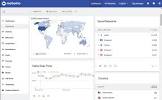The Power of Web Data Analytics
In today’s digital age, the internet has become a treasure trove of valuable data that businesses can leverage to gain insights and make informed decisions. Web data analytics is the process of collecting, analysing, and interpreting data from websites to understand user behaviour, preferences, and trends.
Understanding User Behaviour
Web data analytics allows businesses to track how users interact with their websites. By monitoring metrics such as page views, bounce rates, time spent on site, and conversion rates, companies can gain a deeper understanding of user behaviour. This insight helps them identify areas for improvement and optimisation to enhance the overall user experience.
Personalising User Experience
By analysing web data, businesses can segment their audience based on demographics, interests, and browsing patterns. This segmentation enables companies to deliver personalised content and recommendations to users, increasing engagement and driving conversions. Personalisation based on web data analytics can lead to higher customer satisfaction and loyalty.
Improving Marketing Strategies
Web data analytics plays a crucial role in measuring the effectiveness of marketing campaigns. By tracking key performance indicators (KPIs) such as click-through rates, conversion rates, and return on investment (ROI), businesses can evaluate the success of their marketing efforts. This data-driven approach allows companies to optimise their strategies for better results.
Forecasting Trends
Another benefit of web data analytics is its ability to identify emerging trends in user behaviour and market dynamics. By analysing historical data and patterns, businesses can forecast future trends and adapt their strategies accordingly. This proactive approach helps companies stay ahead of the competition and seize opportunities for growth.
The Future of Web Data Analytics
As technology continues to evolve, so does web data analytics. With advancements in artificial intelligence (AI) and machine learning algorithms, businesses can now extract even deeper insights from web data. The future of web data analytics holds exciting possibilities for enhanced personalisation, predictive analytics, and real-time decision-making.
In conclusion, web data analytics is a powerful tool that empowers businesses to make informed decisions based on actionable insights derived from website data. By harnessing the power of web data analytics, companies can drive growth, improve customer experiences, and stay competitive in today’s digital landscape.
Enhancing Your Website: 6 Essential Tips for Effective Web Data Analytics
- Define clear goals and objectives for your web data analytics efforts.
- Use tools like Google Analytics to track and analyse website traffic.
- Regularly monitor key performance indicators (KPIs) to measure the success of your website.
- Utilise A/B testing to experiment with different strategies and improve user experience.
- Understand user behaviour on your website through heatmaps and session recordings.
- Stay updated with the latest trends and developments in web data analytics.
Define clear goals and objectives for your web data analytics efforts.
To maximise the effectiveness of your web data analytics efforts, it is essential to define clear goals and objectives from the outset. By establishing specific targets that align with your business objectives, you can focus your analysis on key metrics that matter most. Clear goals help guide your data collection and analysis processes, ensuring that you extract meaningful insights that drive informed decision-making. Whether it’s improving user engagement, increasing conversions, or enhancing marketing strategies, setting clear goals for web data analytics enables you to measure success and continuously refine your approach for optimal results.
Use tools like Google Analytics to track and analyse website traffic.
To enhance your understanding of user behaviour and optimise your website performance, it is advisable to utilise tools such as Google Analytics for tracking and analysing website traffic. By leveraging platforms like Google Analytics, businesses can gain valuable insights into visitor demographics, popular pages, referral sources, and user engagement metrics. This data enables informed decision-making, allowing companies to tailor their content and marketing strategies to better meet the needs of their target audience.
Regularly monitor key performance indicators (KPIs) to measure the success of your website.
Regularly monitoring key performance indicators (KPIs) is essential for evaluating the effectiveness of your website and online strategies. By tracking metrics such as traffic sources, conversion rates, bounce rates, and average session duration, you can gain valuable insights into how users interact with your site. This data allows you to identify areas of improvement, optimise user experience, and make informed decisions to enhance the overall performance of your website. Consistent monitoring of KPIs ensures that you stay on track towards achieving your business goals and maintaining a competitive edge in the digital landscape.
Utilise A/B testing to experiment with different strategies and improve user experience.
Utilising A/B testing in web data analytics is a valuable strategy to experiment with different approaches and enhance user experience. By creating variations of web elements or content and testing them on different segments of users, businesses can gather data on what resonates best with their audience. This empirical approach allows companies to make data-driven decisions, refine their strategies, and ultimately deliver a more tailored and engaging user experience. A/B testing empowers businesses to continuously iterate and improve, ensuring that their website optimisation efforts are effective and impactful.
Understand user behaviour on your website through heatmaps and session recordings.
To gain valuable insights into user behaviour on your website, consider utilising tools such as heatmaps and session recordings. Heatmaps visually represent where users are clicking, scrolling, and spending the most time on your site, providing a clear indication of user engagement and interaction patterns. Session recordings offer a more detailed view by capturing individual user sessions, allowing you to observe how users navigate through your website in real-time. By analysing data from heatmaps and session recordings, you can better understand user preferences, identify areas for improvement, and enhance the overall user experience on your website.
Stay updated with the latest trends and developments in web data analytics.
To maximise the effectiveness of web data analytics, it is crucial to stay updated with the latest trends and developments in the field. As technology evolves rapidly, new tools, techniques, and best practices emerge regularly. By staying informed about the latest trends in web data analytics, businesses can ensure that they are leveraging the most advanced methods to extract valuable insights from their website data. Keeping abreast of developments in this dynamic field allows companies to adapt their strategies proactively, stay competitive, and make data-driven decisions that drive success.






